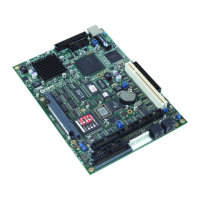SBC-GX1 Technical Manual Getting started with your SBC-GX1
Using the CompactFlash socket
The SBC-GX1 has a Type II CompactFlash socket mounted on the underside of the
board. This socket is connected to the secondary IDE controller. The socket supports
both Type I and Type II CompactFlash cards. If a CompactFlash card is plugged into the
socket it acts as a normal hard disk drive and is detected by the BIOS during the POST
process. If the card has an operating system loaded and there are no standard hard
disk drives connected the board boots from the CompactFlash card and this becomes
drive C:.
The CompactFlash card can only be inserted into the socket one way. The correct
orientation is for the top of the card i.e. the normal printed side to be closest to the PCB.
Connecting a mouse
A PS/2 mouse can be connected to PL9. A suitable mouse is supplied as part of the
development kit and a driver has been included on the support CD to enable this mouse
to be used under DOS. Windows 98/2000/NT/XP provides mouse support via built-in
drivers.
Using the serial interfaces (RS232)
The four serial port interfaces on the SBC-GX1 are fully PC compatible. These are
decoded at standard PC address locations for COM1, COM2, COM3 and COM4.
PC applications can use these ports without any special configuration. COM3 and
COM4 can use non-standard IRQ lines, which enables all four ports to have an
individual IRQ assigned. See the
Jumpers and connectors section, page 18, for details.
Connection to the serial ports is via a 10-way boxed header. The pin assignment of
these headers is arranged to enable a 9-way IDC D-Type Plug to be connected directly
to pins 1-9 on the cable. The D-Type connector is compatible with the standard 9-way
connector on a desktop machine. A suitable cable is provided in the development kit.
See
Appendix B – Connector details for pin details.
Connecting a printer
An enhanced printer port is incorporated onto the SBC-GX1. This port can be used to
support a Centronics-compatible printer or ECP/EPP bi-directional device. The signals
are routed to a 26-way boxed header and the pin assignment has been arranged to
allow 1:1 connection with a 25-way IDC D-Type socket. This socket is compatible with a
standard printer port connector on a desktop machine. See
Appendix B – Connector
details
for pin details.
Using the audio features
There are three audio interfaces supported on the SBC-GX1: line in, line out and
microphone. the line in and line out interfaces support stereo signals and the
microphone provides a mono input. Connections are routed to a 10-way boxed header
PL24. The relevant signals for each interface are shown in
Appendix B – Connector
details
.
© 2004 Arcom Issue D 15

